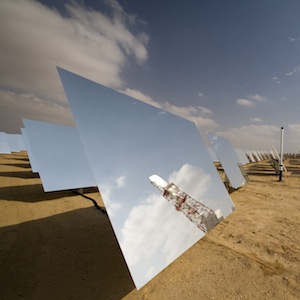A big solar developer makes a major move toward storing electricity

A major barrier for solar power has always been that it doesn’t work at night (Duh). A few years ago, developers of big “utility-scale” solar projects were able to shrug this off to some degree. But Oakland-based BrightSource Energy has reversed field and decided to add to several projects the ability to store electricity for distribution after dark.
BrightSource managers say times have changed. Where utilities once wanted all the renewable capacity they could get, to meet state requirements, the priority has since shifted to having those renewable electrons available when they’re needed.
“The challenges of integrating photovoltaics and wind into the grid have driven a much deeper appreciation for those that can be highly reliable,” BrightSource CEO John Woolard told me in a phone interview.
But another driver is — well — us. When I interviewed Woolard a couple of years ago, I asked him why his company wasn’t including storage technology in its California projects. He said it wasn’t needed in California, which had a different pattern of electrical use than, say, Arizona.
That’s changing. Woolard says peak demand, which has traditionally hit around 4 p.m., has been shifting to later in the day, and by the end of this decade, will probably happen around 6 p.m. He says changing lifestyles are behind the shift, such as when people arrive home and fire up their air conditioners and other appliances.
As modern lifestyles evolve, our reliance on home appliances has grown significantly. People now come home after a long day and immediately switch on their air conditioners, washing machines, and kitchen gadgets, putting extra demand on these systems. With constant use, even the most reliable appliances can experience wear and tear, requiring regular maintenance to keep them functioning efficiently. That’s why having access to a professional appliance repair service is more important than ever, especially in regions where high usage is common.
Appliance repair services, mainly in Travis County, are equipped to handle everything from minor issues to major breakdowns. Whether it’s an overworked air conditioner or a washing machine that refuses to spin, trained technicians can diagnose and fix the problem before it becomes more costly. Regular tune-ups can also prevent unexpected failures, ensuring that your appliances continue to support your lifestyle without interruption.
Just as our appliances require regular maintenance to keep up with modern demands, so too does the plumbing system that supports them. From kitchen sinks and dishwashers to washing machines and water heaters, the functionality of your home depends heavily on a well-maintained plumbing infrastructure.
Over time, constant use and pressure on pipes, faucets, and drains can lead to leaks, blockages, or even major breakdowns. That’s why it’s crucial to invest in regular plumbing checkups and repairs. By catching small issues early, you can prevent larger, more expensive problems down the road. Services like plumbers perth specialize in both routine maintenance and emergency repairs, ensuring your plumbing system can keep pace with your daily routine. Whether it’s ensuring that your dishwasher drains correctly or that your washing machine has the proper water pressure, professional plumbing services can save you from the inconvenience and potential damage of faulty systems.
Much like appliance repair, staying ahead of plumbing issues allows homeowners to maintain the comfort and efficiency of their living spaces. And with the right professionals on hand, you can rest assured that your home’s vital systems—both plumbing and appliances—are functioning in harmony.
This proactive approach not only extends the lifespan of your appliances but also prevents the stress and costs associated with unexpected plumbing failures.
BrightSource says it will use a molten-salt technology to store the power, rather than huge banks of batteries or experimental technologies such as flywheels. “That’s a solution for 2050 or 2060,” Woolard told me, “depending on whether you’re an optimist or a pessimist.”
Here’s a good summary of how it works, from The Energy Blog:
“The molten salt, with properties like water at temperatures above its 240oC (464oF) melting point, is pumped from a large storage tank to the receiver, where it is heated in tubes to temperatures of 565oC (1049oF). The salt is then returned to a second large storage tank, where it remains until needed by the utility for power generation. At that time, the salt is pumped through a steam generator to produce the steam to power a conventional, high-efficiency steam turbine to produce electricity. The salt at 285oC (545oF) then returns to the first storage tank to be used in the cycle again.”
BrightSource will add molten-salt units to three of its projects in Riverside and San Bernardino Counties, but not to its Ivanpah Valley project, already under construction near the Nevada border. Spokesman Keely Wachs says that the added cost will be “fairly nominal,” and that expanding the plants’ operating hours will, in effect, reduce the price of energy from those plants.
CEO Woolard says that despite plunging prices for conventional photovoltaic solar panels, BrightSource will not be joining a trend among developers to convert some of their giant solar arrays to PV. He says PV output tends to peak at noon (PV power is a function of light, not heat), so their output is falling just as demand is rising. He says that by adding storage capacity to solar-thermal plants such as his,”You can extend when you deliver power and and you’re delivering more of it when the real system peak is.”

